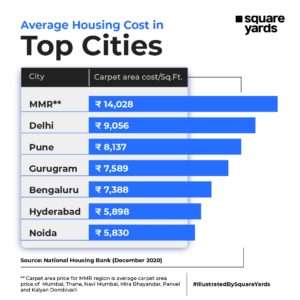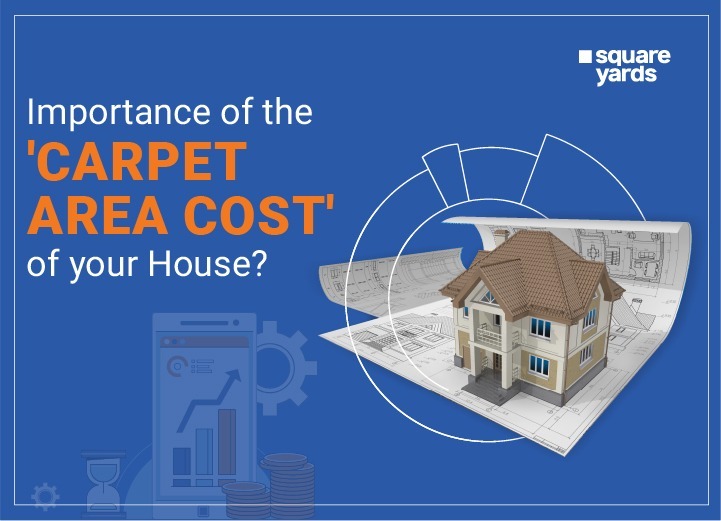There are multiple ways of calculating the average housing cost of a city. However, considering the carpet area cost of a dwelling unit seems to be the most buyer-friendly way to decode whether the property is worth your money or not. The National Housing Bank (NHB) released a list of the average housing cost in top cities on the basis of Carpet Area. Square Yards takes a look at which cities top the list and why carpet area is important in this context.
Before the setting up of RERA, there were multiple anomalies surrounding the built-up area of residential units and the corresponding prices quoted by builders. Given the ambiguous nature of the real estate market and the loosely defined technical terminologies, home buyers were often duped by developers.
However, with RERA becoming a reality in 2016, it became mandatory for builders to mention the carpet area price on all sale and marketing documents. Builders who earlier used to offer sale price on the built-up area of the residential unit, are now obligated to offer details on carpet area as well. Knowing the per Sq. Ft. cost of a property based on carpet area allows a buyer to assess if the investment offers value for the money spent. How? Let’s dive in further and understand what carpet area stands for and how it differs across top cities and contributes to the price of your home.
Housing Cost across top cities based on carpet area
Based on the data released by NHB under the purview of NHB RESIDEX, for the last quarter of 2020, MMR (Mumbai Metropolitan Region) topped the list of ‘average housing cost in top cities’. The average carpet area cost of a dwelling unit in MMR was Rs 14,028 Sq. Ft. This was followed by Delhi and Pune with an average price of
Rs 9,056 and Rs 8,137 respectively.

However, Hyderabad and Noida were more affordable with the carpet area cost of residential units hovering around at Rs 5,800-5,900/Sq. Ft.
What is carpet area? How is it calculated?
As per RERA, carpet area is defined as the ‘net usable floor area in a building/apartment which excludes the outside balcony or verandah attached to the unit. Also, as the name suggests, it means the net area on which one can spread the carpet.
Usually, it is very easy to calculate the net usable area of a particular apartment and adjoining area, as the drawings for floor plan are developed on CAD (Computer Aided Design) software. Therefore, calculations for carpet area can be easily understood by the home buyer. In most of the cases, carpet area is usually 75% of the super-built-up area.
Why is it important for home buyers to have an in-depth understanding of carpet area?
With many developers providing information only on super built and built-up area rather than carpet area, which is always less, it becomes more pressing to have a lucid understanding of the exact measurement of the apartment home buyers will receive from the developer.
As per the definition laid by RERA, built- up area of an apartment includes extra spaces such as area of the outer and inner walls and dry balcony areas, in addition to the carpet area. Whereas super built-up area apart from being inclusive of carpet area and built-up area, also includes the portion of the balance area, such as stairs, lobbies etc. which is accessible by residents of the entire building. Developers used to quote prices of their projects on the basis of the super-built area as it gave the wrong sense about the size of the apartment. It was far more alluring for developers as quoting the super-built-up area meant reduced per Sq. Ft. cost.
In most projects loading accounts for approximately 30-35% of the total area, with only 70-75% being the net usable area. For example, if the builder cited 2,000 Sq. Ft as the total area of an apartment, only 1,400-1,300
Sq. Ft. will be the actual area owned by the home buyer, remaining being the common area used by all the residents.
Now, if you calculate the housing cost as per the carpet area, the property rates per Sq. Ft. comes out to be way higher than when it is calculated on built-up or super built-up, as the total price of the house is now divided by a lower denominator.
For example, a residential unit priced at Rs 50 Lakhs, will cost Rs 2,500 per Sq. Ft. if the super-built-up area is 2000 Sq. Ft. However, the per Sq. Ft. value of the same unit gets bloated to Rs 3,333 if the cost is calculated on the carpet area, which would be 1,500 Sq. Ft. at 25% loading.
Pandemic challenges rendering carpet area more crucial
The world is still struggling to come to terms with the losses incurred due to the ongoing pandemic. Spacious homes, which were once considered a luxury, have now become the need of the hour. Apart from offering a safe abode, one’s home has also become the new workplace, school, and a place for recreation. Hence, the need to have a greater net usable area, makes it imperative for home buyers to have the exact knowledge of the actual area of the house they are planning to buy.
With RERA expanding its footprints and disclosure of carpet area becoming mandatory, efficacious and good design will now become crucial. Builders are now more focused on optimizing the common area space so that they can offer a higher carpet area for the same super built-up area.





























